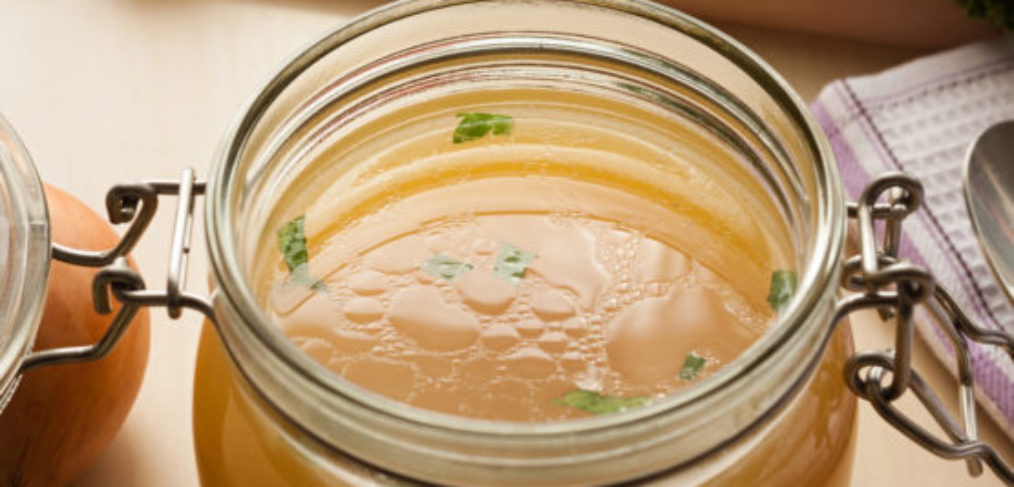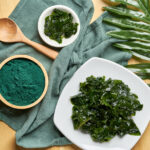Bone Broth 101

Have you heard?
Bone broth is the hot (or cold), trending drink / meal replacement / (dare I say?) recovery drink from sport (if you’re training fasted) and if you haven’t experienced yet, now is the time to dive in and learn more.
But just exactly what is it?
Interestingly, bone broth is not actually a broth, but a combination of broth and stock (1), (2).
Broth is a liquid food preparation, typically consisting of water, in which bones, meat, fish, cereal grains, or vegetables have been simmered. Broth is used as a basis for other edible liquids such as soup, gravy, or sauce.
Stock tends to be made more from bony parts, whereas broth is made more out of meat. Stock tends to have a fuller mouth feel and richer flavor, due to the gelatin released by long-simmering bones.
Bone broth is really a hybrid of broth and stock. The base is more stock-like, as it usually made from roasted bones, but there can sometimes be some meat still attached. It is cooked for a long period of time, often more than 24 hours, and the goal is to not only extract the gelatin from the bones, but also release the nutritious minerals. It is then strained and seasoned to be enjoyed on its own, like broth[3].
Bone broth recipes often include vinegar, or for a more Paleo-friendly version, lemon or lime, which helps draw the minerals out of the bone (magnesium, calcium, zinc, boron, and others), making it even richer and more nourishing that it’s more main stream relative.
And why should we be partaking of this?
First of all, there are numerous health benefits, including, but certainly not limited to:
It’s rich in proline and glycine (important for a healthy gut and digestion, muscle repair and growth, a balanced nervous system, and strong immune system).
The gelatin in bone broth can help to heal a leaky gut.
Also helps to reduce joint pain, inflammation, prevent bone loss, and build healthy skin, hair, and nails.
Bone marrow helps the immune system by carrying oxygen to cells in the body maintaining healthy bones and generating energy.
Using cartilage-rich bones such as knuckles and chicken feet is said to be effective in treating arthritis and other degenerative joint diseases.
Next, there’s the nose to tail component of it: using all of the wild, grass – fed and pasture fed animals of which we’ve been a bit too selective over the past few generations in terms of choosing which parts we will or will not eat.
I’m in this very category myself, by the way.
For years, I was so fat phobic, I only ate skinless chicken breast, 99% fat free ground turkey and never in a million years would I even entertain the thought of eating salmon skin.
Thankfully, I learned about an authentic Paleo approach to eating, followed by nose to tail dining and then, how to integrate a ketogenic approach into the mix.
Who should be drinking this, and how often?
Honestly, bone broth is something we can all benefit from. Not only are there numerous health benefits, but there are ways to incorporate bone broth into our daily regimes, above and beyond simply drinking it.
Heat up a cup in the afternoon instead of another cup of coffee, use it as a base for a stew or sauce, or, for those of you fellow athletes out there, use it as a recovery drink after training!
Think about it: you’ve been sweating, you’ve become dehydrated, even more so when you’re burning fat instead of carbs, so what better way to nourish your body than an age old, easy to prepare, easy to digest and oh-so-good-for-the-gut beverage?
(Psst: you’re not going to be the only one relying on this natural way to rebuild and rejuvenate; according to NPR[3], the LA Lakers are downing it like there’s no tomorrow.
After all, it’s a nice way to rehydrate the body, because of the liquid, and then replenish the sodium (electrolyte) that was lost through sweat during exercise, plus the amino acids may also provide the body with the building blocks it needs to rebuild muscle (4).
Now the fun part: how does one procure this elixir?
If you’re more of a hands-on kinda person, It’s super easy to make yourself as there are only three essential ingredients: bones, water and a scant 1 Tablespoon of vinegar, which helps to extract the nutrients from the bones during the cooking process.
The easiest thing to do is save your bones from any and all meals in large ziplock bags in the freezer until you have enough to fill your slow cooker.
No two batches are alike; check out my basic recipe here.
Of course, you can make it complex by adding your choice of herbs and spices for even more of a health-boosting bang.
Not interested in making your own?
Not a problem as there are some very viable options on the market these days… such as mine!
Find us:
1 -My son and I continue to sell our broths at at our most popular market: Brentwood Farmer’s Market (Sundays 9-2) 741 Gretna Green Way, Los Angeles, CA 90049
2 -Coming very soon: on the shelves of all 6 Erewhon Locations!
3- Home delivery throughout greater Los Angeles
4- On the shelves at Farmshop LA.
Stay tuned for more on some very unique ways to procure, prepare and enjoy this age-old, traditional panacea!
[1] “Chicken Stock vs. Chicken Broth : Recipes and Cooking : Food Network.” Chicken Stock vs. Chicken Broth : Recipes and Cooking : Food Network. N.p., n.d. Web. 29 Oct. 2015
2] “Stock, Broth, and Bone Broth-What’s the Difference?” Epicurious. N.p., n.d. Web. 29 Oct. 2015
[3] Moskin, Julia. “Bones, Broth, Bliss.” The New York Times. The New York Times, 06 Jan. 2015. Web. 30 Mar. 2016.
[4]“Why Should Endurance Athletes Burn Fat for Fuel?” The Paleo Diet. N.p., 17 May 2015. Web. 30 Mar. 2016





